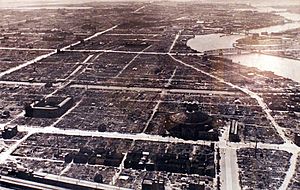Japan campaign facts for kids
Quick facts for kids Japan campaign |
|||||||
|---|---|---|---|---|---|---|---|
| Part of Pacific War | |||||||
 Task Force 38, of the U.S. Third Fleet maneuvering off the coast of Japan, 17 August 1945, two days after Japan agreed to surrender. |
|||||||
|
|||||||
| Belligerents | |||||||
|
|
|||||||
| Commanders and leaders | |||||||
|
|
|
||||||
| Casualties and losses | |||||||
| Comparatively light | 193,300 soldiers dead (all causes) Surrendered and captured following blockade and bombings: 4,335,000 soldiers 9,435 artillery pieces 5,286 tanks 731 other AFVs 12,682 aircraft (mostly kamikazes) |
||||||
The Japan campaign was a series of important battles. These fights happened in and around Japan during the final part of World War II. It was part of the larger Pacific War. The campaign lasted from about June 1944 to August 1945. It involved Allied forces fighting against Imperial Japan.
Contents
Air Attacks on Japan
The first attacks by Allied forces were air raids on Japan. These raids started in late 1944. They involved heavy bombing of Japanese cities and factories. The goal was to destroy Japan's ability to fight.
Some of the most important air attacks included:
- Tokyo Firebombing (March 9-10, 1945): This was a huge firebombing raid. About 100,000 Japanese people died, mostly civilians. The fires caused massive damage across the city.
- Bombing of Kure (July 24-28, 1945): In this attack, most of Japan's remaining large warships were destroyed. This left Japan with very few big ships.
- Atomic Bombing of Hiroshima (August 6, 1945): This was the first time an atomic bomb was used in war. It caused between 90,000 and 140,000 deaths. Many of those who died were civilians.
- Atomic Bombing of Nagasaki (August 9, 1945): The second atomic bomb was dropped on Nagasaki. This attack killed between 39,000 and 80,000 people.
These air raids caused a lot of damage to Japan. Hundreds of thousands of Japanese citizens died. Japan also lost thousands of aircraft and anti-aircraft guns. The Allies, however, lost only a few hundred planes.
Major Land and Sea Battles
In early 1945, there were two very tough island battles. These battles showed how fiercely Japan would fight.
Battles for Islands
- Battle of Iwo Jima (February 16 to March 26, 1945): This was a very bloody battle. Out of about 21,000 Japanese defenders, only 216 survived.
- Battle of Okinawa (April 1 to June 21, 1945): This battle was even larger. About 100,000 Japanese defenders fought. Only 24,455 survived.
In both Iwo Jima and Okinawa, the Japanese soldiers fought until almost all of them were gone. They rarely surrendered. This made the battles very costly for the Allied forces too.
There were also two important naval battles:
- Operation Ten-Go (April 7, 1945): This was a Japanese naval mission. Almost all of the Japanese ships involved were lost.
- Battle of Tokyo Bay (July 22 and 23, 1945): In this battle, most of the Japanese ships were heavily damaged or destroyed.
Allied warships also attacked several Japanese cities from the sea. These bombardments happened in July and August 1945.
Soviet Invasions
In late 1945, the Soviet Union also launched attacks on Japanese territories to the north. These invasions were in preparation for a possible attack on Hokkaido, a large Japanese island.
- Invasion of South Sakhalin (August 11-25)
- Invasion of the Kuril Islands (August 18 to September 1)
The End of the War
World War II finally ended when Japan surrendered. This happened after the atomic bombings of Hiroshima and Nagasaki. Before these two attacks, Japan was not willing to give up. Even the massive firebombing of Japanese cities, which killed many civilians, did not make the government surrender.
The Japanese government was ready to fight very hard against any Allied invasion of their home islands. They had shown this in the battles of Iwo Jima and Okinawa. The Japan campaign helped prepare for a possible invasion. It also supported the air and naval attacks against Japan.
Japan still had a large army of about two million soldiers. They also had enough resources to cause serious problems for an Allied invasion. If an invasion had been needed, it would likely have led to many more deaths on both sides.
See also
- Surrender of Japan
- Japanese Instrument of Surrender
- Occupation of Japan
- United States strategic bombing of Japan
- Soviet invasion of Manchuria
- Victory over Japan Day


